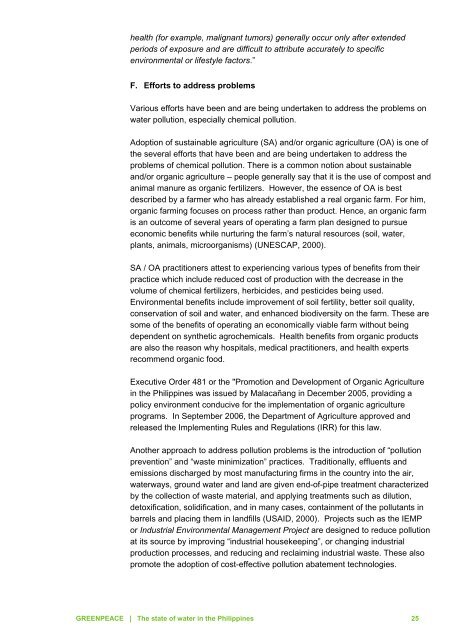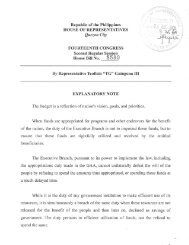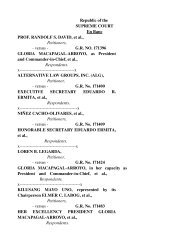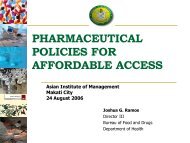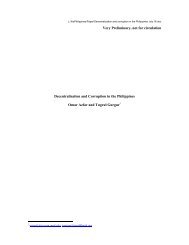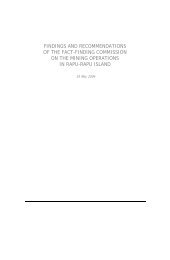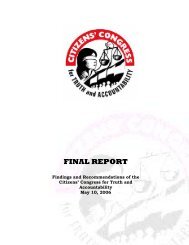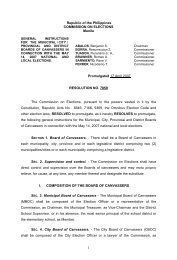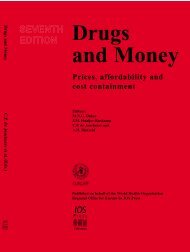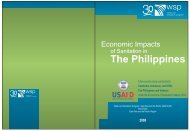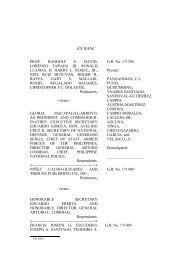The state of water resources in the Philippines - Greenpeace
The state of water resources in the Philippines - Greenpeace
The state of water resources in the Philippines - Greenpeace
You also want an ePaper? Increase the reach of your titles
YUMPU automatically turns print PDFs into web optimized ePapers that Google loves.
health (for example, malignant tumors) generally occur only after extended<br />
periods <strong>of</strong> exposure and are difficult to attribute accurately to specific<br />
environmental or lifestyle factors.”<br />
F. Efforts to address problems<br />
Various efforts have been and are be<strong>in</strong>g undertaken to address <strong>the</strong> problems on<br />
<strong>water</strong> pollution, especially chemical pollution.<br />
Adoption <strong>of</strong> susta<strong>in</strong>able agriculture (SA) and/or organic agriculture (OA) is one <strong>of</strong><br />
<strong>the</strong> several efforts that have been and are be<strong>in</strong>g undertaken to address <strong>the</strong><br />
problems <strong>of</strong> chemical pollution. <strong>The</strong>re is a common notion about susta<strong>in</strong>able<br />
and/or organic agriculture – people generally say that it is <strong>the</strong> use <strong>of</strong> compost and<br />
animal manure as organic fertilizers. However, <strong>the</strong> essence <strong>of</strong> OA is best<br />
described by a farmer who has already established a real organic farm. For him,<br />
organic farm<strong>in</strong>g focuses on process ra<strong>the</strong>r than product. Hence, an organic farm<br />
is an outcome <strong>of</strong> several years <strong>of</strong> operat<strong>in</strong>g a farm plan designed to pursue<br />
economic benefits while nurtur<strong>in</strong>g <strong>the</strong> farm’s natural <strong>resources</strong> (soil, <strong>water</strong>,<br />
plants, animals, microorganisms) (UNESCAP, 2000).<br />
SA / OA practitioners attest to experienc<strong>in</strong>g various types <strong>of</strong> benefits from <strong>the</strong>ir<br />
practice which <strong>in</strong>clude reduced cost <strong>of</strong> production with <strong>the</strong> decrease <strong>in</strong> <strong>the</strong><br />
volume <strong>of</strong> chemical fertilizers, herbicides, and pesticides be<strong>in</strong>g used.<br />
Environmental benefits <strong>in</strong>clude improvement <strong>of</strong> soil fertility, better soil quality,<br />
conservation <strong>of</strong> soil and <strong>water</strong>, and enhanced biodiversity on <strong>the</strong> farm. <strong>The</strong>se are<br />
some <strong>of</strong> <strong>the</strong> benefits <strong>of</strong> operat<strong>in</strong>g an economically viable farm without be<strong>in</strong>g<br />
dependent on syn<strong>the</strong>tic agrochemicals. Health benefits from organic products<br />
are also <strong>the</strong> reason why hospitals, medical practitioners, and health experts<br />
recommend organic food.<br />
Executive Order 481 or <strong>the</strong> "Promotion and Development <strong>of</strong> Organic Agriculture<br />
<strong>in</strong> <strong>the</strong> Philipp<strong>in</strong>es was issued by Malacañang <strong>in</strong> December 2005, provid<strong>in</strong>g a<br />
policy environment conducive for <strong>the</strong> implementation <strong>of</strong> organic agriculture<br />
programs. In September 2006, <strong>the</strong> Department <strong>of</strong> Agriculture approved and<br />
released <strong>the</strong> Implement<strong>in</strong>g Rules and Regulations (IRR) for this law.<br />
Ano<strong>the</strong>r approach to address pollution problems is <strong>the</strong> <strong>in</strong>troduction <strong>of</strong> “pollution<br />
prevention” and “waste m<strong>in</strong>imization” practices. Traditionally, effluents and<br />
emissions discharged by most manufactur<strong>in</strong>g firms <strong>in</strong> <strong>the</strong> country <strong>in</strong>to <strong>the</strong> air,<br />
<strong>water</strong>ways, ground <strong>water</strong> and land are given end-<strong>of</strong>-pipe treatment characterized<br />
by <strong>the</strong> collection <strong>of</strong> waste material, and apply<strong>in</strong>g treatments such as dilution,<br />
detoxification, solidification, and <strong>in</strong> many cases, conta<strong>in</strong>ment <strong>of</strong> <strong>the</strong> pollutants <strong>in</strong><br />
barrels and plac<strong>in</strong>g <strong>the</strong>m <strong>in</strong> landfills (USAID, 2000). Projects such as <strong>the</strong> IEMP<br />
or Industrial Environmental Management Project are designed to reduce pollution<br />
at its source by improv<strong>in</strong>g “<strong>in</strong>dustrial housekeep<strong>in</strong>g”, or chang<strong>in</strong>g <strong>in</strong>dustrial<br />
production processes, and reduc<strong>in</strong>g and reclaim<strong>in</strong>g <strong>in</strong>dustrial waste. <strong>The</strong>se also<br />
promote <strong>the</strong> adoption <strong>of</strong> cost-effective pollution abatement technologies.<br />
GREENPEACE | <strong>The</strong> <strong>state</strong> <strong>of</strong> <strong>water</strong> <strong>in</strong> <strong>the</strong> Philipp<strong>in</strong>es 25


